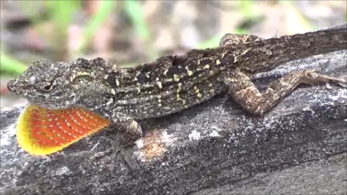Brown anole
| Brown Anole | |
|---|---|

| |
| Male displaying dewlap | |
| Scientific classification | |
| Domain: | Eukaryota |
| Kingdom: | Animalia |
| Phylum: | Chordata |
| Class: | Reptilia |
| Order: | Squamata |
| Suborder: | Iguania |
| Family: | Dactyloidae |
| Genus: | Anolis |
| Species: | A. sagrei
|
| Binomial name | |
| Anolis sagrei | |
| Synonyms | |
| |
The brown anole (Anolis sagrei), also known as the Bahaman anole or De la Sagra's Anole,[1] is a lizard native to Cuba and the Bahamas. It has been widely introduced elsewhere, by being sold as a pet lizard, and is now found in Florida and as far north in the United States as southern Georgia, Texas, Louisiana, Mississippi, Alabama, Hawaii, and Southern California.[2][3][4] It has also been introduced to other Caribbean islands and Taiwan in Asia.
This species is highly invasive.[5] In its introduced range, it reaches exceptionally high population densities, is capable of expanding its range very quickly, and both outcompetes and consumes many species of native lizards.[6][7][8] The brown anole's introduction into the United States in the early 1970s[9] has altered the behavior and triggered a negative effect on populations of the native Carolina anole (Anolis carolinensis, also known as the green anole), which have generally been relegated to the treetops.
Description
The brown anole is normally a light brown color with darker brown to black markings on its back, and several tan to light color lines on its sides. Like other anoles, it can change color, in this case a darker brown to black. Its dewlap ranges from yellow to orange-red. The males can grow as large as their green anole male counterparts, around 17.8–20.3 cm (7.0–8.0 in) long, with some individuals topping 22.9 cm (9.0 in). The females are also around the size of female green anoles: 7.6–15 cm (3.0–5.9 in). The male brown anole's head is smaller than that of the male green anole. Also, the brown anole's tail has a ridge that travels all the way up to behind the head, a feature the green anole lacks.
-
Male extending dewlap
-
Florida female
-
Female
-
Grand Cayman juvenile
-
Male extending his dewlap in Citrus County, Florida
Shedding
Brown anoles molt in small pieces, unlike some other reptiles, which molt in one large piece. Anoles may consume the molted skin to replenish supplies of calcium.[10] In captivity, the molted skin may stick to the anole if humidity is too low. The unshed layer of skin can build up around the eyes, preventing the lizard from feeding and may lead to starvation. This can be prevented by maintaining high humidity.
Diet
Brown anoles feed on small arthropods such as crickets, moths, ants, grasshoppers, cockroaches, mealworms, spiders, and waxworms.They may also eat other lizards, such as skinks and the green anole, lizard eggs, and their own molted skin and detached tails. If near water, they eat aquatic arthropods or small fish – nearly anything that will fit in their mouths.

Predation
As a defense mechanism, the brown anole can detach most of its tail when pursued or captured. The piece that breaks off will continue to move, possibly distracting the predator and allowing the anole to escape. The lost tail will partially regrow.[11] If provoked, the brown anole will bite, urinate, and defecate. Predators include rats, snakes, birds and many larger animals such as cats.
Recent work in experimentally introduced populations in the Bahamas has shown that body size in the brown anole may not be affected by predation, as was previously thought.[12]
Communication
Anoles use visual cues as their primary signaling mode.[13] However, recent evidence suggests that male brown anoles are also capable of sensing chemical cues that are left behind by female conspecifics.[14]
References
- ^ "Common Name: Anole - Bahaman". The Central Pets Educational Foundation. Archived from the original on 2014-02-21. Retrieved 2014-02-08.
{{cite web}}: Unknown parameter|deadurl=ignored (|url-status=suggested) (help) - ^ Gary Nafis (2013). "Non-Native Reptiles and Amphibians Established In California". CaliforniaHerps.com. Retrieved 2013-02-01.
- ^ Glorioso, Brad Michael. "Amphibians and Reptiles of Louisiana".
- ^ Glover, Joel D. "Brown Anole". Outdoor Alabama.
- ^ Kolbe, J.J.; Glor, R.E.; Schettino, L.R.; Lara, A.C.; Larson, A.; Losos, J.B. (2004). "'Genetic variation increases during biological invasion by a Cuban lizard". Nature. 431: 177–181. doi:10.1038/nature02807.
- ^ Losos, J.B.; Marks, J.C.; Schoener, T. W. (1993). "Habitat use and ecological interactions of an introduced and a native species of Anolis lizard on Grand Cayman, with a review of the outcomes of anole introductions". Oecologia. 95: 525–532. doi:10.1007/bf00317437.
- ^ Campbell, T.S. (2000). Analysis of the effects of an exotic lizard (Anolis sagrei) on a native lizard (Anolis carolinensis) in Florida, using islands as experimental units. PhD Thesis, Univ. of Tennessee.
- ^ Gerber, G.P.; Echternacht, A.C. (2000). "Evidence for asymmetrical intraguild predation between native and introduced Anolis lizards". Oecologia. 124: 599–607. doi:10.1007/s004420000414.
- ^ R.D. and Patti Bartlett (2013). "Choosing a Brown Anole". PetPlace dot com. Retrieved 2013-01-16.
- ^ "Brown Anole". Animal Spot. Retrieved 2017-12-06.
- ^ Casanova, L. (2004). Norops sagrei (On-line), Animal Diversity Web. Accessed July 31, 2008
- ^ Calsbeek, R.; Cox, R.M. (2010). "Experimentally assessing the relative importance of predation and competition as agents of selection". Nature. 465: 613–616. doi:10.1038/nature09020. PMID 20453837.
- ^ Losos J.B. 2009. Lizards in an Evolutionary Tree: Ecology and Adaptive Radiation of Anoles. University of California Press, Berkeley.
- ^ Baeckens, Simon (March 29, 2016). "Intersexual chemo-sensation in a "visually-oriented" lizard, Anolis sagrei". PeerJ. 4: e1874. doi:10.7717/peerj.1874. PMC 4824904. PMID 27069809.
{{cite journal}}: CS1 maint: unflagged free DOI (link)






